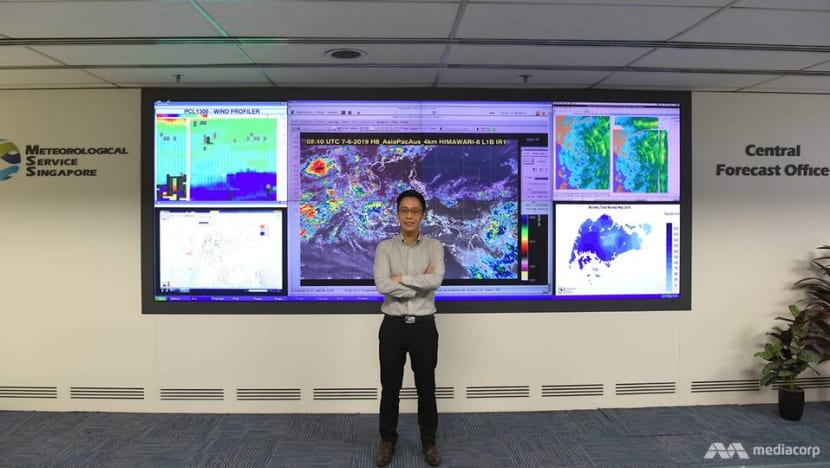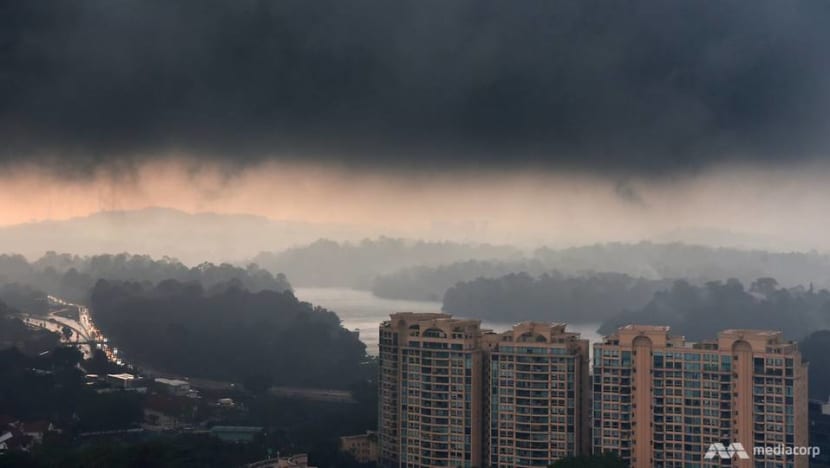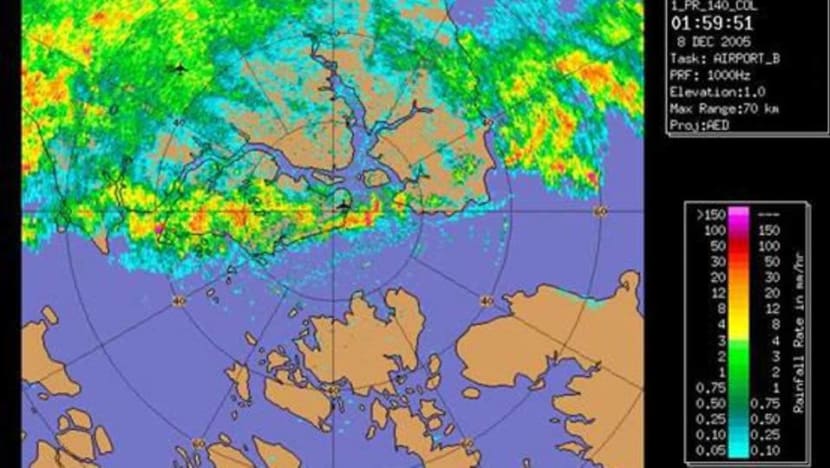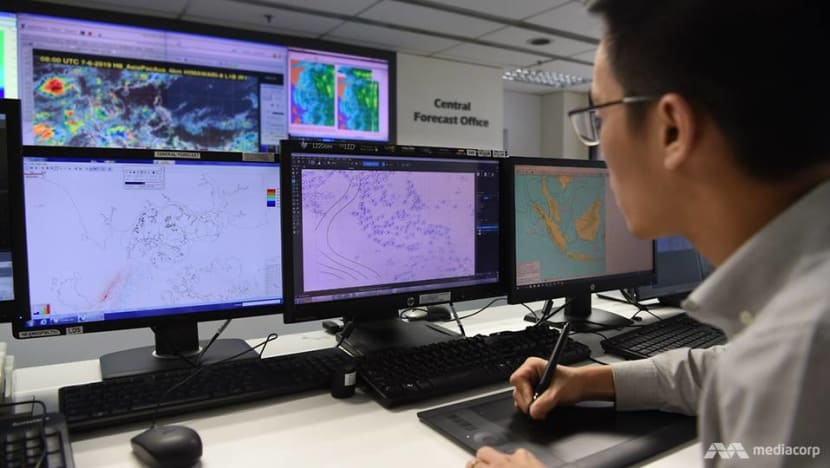'They ask us if we can make it stop raining or make it rain’: Life as a weather forecaster in Singapore

Meteorologist Darryl Boh poses for a photograph. (Photo: Matthew Mohan)
SINGAPORE: Nestled in a corner of Changi Airport, sheltered from the hubbub of one of the world's busiest airports, is the Meteorological Service's Central Forecast Office.
It is from this nondescript space that supercomputers quietly churn out calculations, while a team of 10 operational meteorologists painstakingly go about forecasting the weather.
Contrary to what some may think, their jobs aren't as simple as flipping a coin to predict whether it's going to rain or shine.
"We usually start off analysing the weather and what’s going on around us," meteorologist Darryl Boh told CNA.
"What happens around us affects Singapore itself. Other than the forecast and observations, we also monitor geophysical hazards ... We take phone calls from the public and our subscribers. We either call them to update them on certain weather phenomenon or they will call us up if they have any queries."
Mr Boh and his colleagues work in 12-hour cycles - three meteorologists on the day shift and one on the night shift. The day shift is usually led by a senior meteorologist who is assisted by two operational meteorologists.
"For the (operational) meteorologists, we are in charge of different watch areas," he explained. "The forecaster looking after aviation will be in charge of a slightly larger area, all the way across the South China Sea and also our region. The forecaster in charge of the public will be more focused around Singapore, including looking at the lightning warnings."
While their colleagues are on duty, the other meteorologists perform other duties such as evaluating forecasts as well as answering emails from members of the public.
A FASCINATION WITH FLIGHTS
Having studied mathematics and economics during his time in university, this gave Mr Boh the option of choosing from a variety of jobs in different fields upon graduation.
"When I was studying, I didn’t really think about what I wanted to become, which is why what I studied was quite a broad degree – like mathematics, economics you can go into finance, teaching, science," he recalled. "It was more of exploring what I wanted to do."
After a short stint of two months in his first job at an insurance company, the 29-year-old decided that the corporate life was not for him.
Instead, an online job posting for the role of meteorologist caught his eye.
"All along I’ve had a little bit of interest in weather, in aviation, so it is more of a coincidence," said Mr Boh. "I really like (watching videos of) planes landing in extreme weather because it takes a lot of skill and the understanding of the different weather phenomenon that come about and affect the flight.
"But, I didn’t really think of being a pilot."
After he got the job in late 2016, Mr Boh was sent to Melbourne, Australia for training.

"It was quite difficult especially on the physics side of things, and meteorology has a lot of physics in it - so the part I struggled quite a bit as a university graduate," recalled Mr Boh.
"What I learnt most ... is that weather phenomenon in the tropics and in the mid-latitudes are very different. Over in Australia, in the mid-latitudes, they have very big scale frontal system but in Singapore we have very small scale one - our thunderstorms are maybe one to two kilometers wide," he added.
"So they did try to cater their training to be a bit more tropical related but still, there was a bit of difference."
ANYTHING BUT STRAIGHTFORWARD
It is precisely Singapore's location, as a tiny island in the tropics surrounded by the sea, which makes its weather more difficult to predict, said Mr Boh.
High amounts of moisture in the air, the constant heat and the atmospheric instability make Singapore's weather more "dynamic", he explained.
Mr Boh said: "Because it is so volatile, you just need a small kick and you’ll have thundery showers forming."
These weather systems usually form and dissipate quickly, and with prevailing winds generally light, predicting the movement of localised storms can be difficult.
To prepare a weather forecast, meteorologists such as Mr Boh make use of various observation data from as far as across the region. This can consist of information gathered from satellite and radar imagery, as well as from the more than 100 weather stations across Singapore.
These observations are then plotted onto a map and analysed before a prediction is made.
For longer term predictions, observational data is used as input for numerical weather prediction models, which simulate the future behaviour of the atmosphere.
These models are powered by supercomputers which use scientific, physical laws and mathematic equations and form an assessment of what the weather could look like in the days to come.

"A lot of my uni(versity) friends think that because the technology is so advanced, we just look at the model and decide whether it rains or not," said Mr Boh. "They don’t quite understand that there’s the human factor in this, that at least in Singapore and the tropics, weather forecasting is not that straightforward."
In addition, given that numerical weather prediction models have grid spaces on a scale much larger than the thunderstorms in Singapore, these weather events are often not fully reflected on the model.
"Because we are part of the team, communication is very important," added Mr Boh. "It allows us to tap the knowledge of the senior meteorologist because in Singapore at least, local knowledge is very important, there are a lot of small-scale features that are not captured very well in the models.
"Being part of a team, we can bounce ideas off each other and can tap the experience of our senior meteorologists."
Despite these challenges, the Met Service's accuracy of weather forecasts range between 75 per cent for 24-hour forecasts and 90 per cent for short-term two-hour "nowcasts", the National Environment Agency (NEA) told CNA.

IN THE PUBLIC EYE
Being a meteorologist also requires people skills, as Mr Boh and his colleagues interact with members of the public regularly.
For one, they have regular callers who want to find out weather forecast specific to their location.
"They call just to confirm or check, we have some long-time callers they have been calling just to ask about the weather the next day," he explained. "Usually the public will call and ask about the weather at their location."
"It’s very hard to tell someone, 'Oh that’s the weather' and then hang up on them. Some of them can talk and go on for quite a while. We also have a lot of weird calls, they ask us if we can make it stop raining or make it rain, things like that."
Others dial in to offer their own forecast.
"There are some guys who know their weather, they call us up and give us their forecast," said Mr Boh, who also regularly presents the Met Service's fortnightly weather outlook. "Then we will agree and disagree and talk a little bit. They have been observing it for so long that they probably kind of know."
Given that meteorologists do get forecasts wrong from time to time, Mr Boh has learnt not to take complaints personally.

"When you get your forecast wrong and you get public phone calls, I’ll feel like I misled them, I didn’t value add to their forecast," he said. "Sometimes they will complain and say that it’s not very accurate.
"When that happens, I remind myself, experience really counts. So if the forecast was wrong and I review the weather, I think about how it was wrong, where it went wrong and where I could have done better.
"When you think about it, it helps you improve. You build your experience, you see more and you know more. It helps you do better the next time."
Call it an occupational hazard, but Mr Boh even fields questions about the weather from a more familiar source. "My wife is a school teacher, when she has events, she will ask me about the weather!" he revealed.
And if he ever needs a break, Mr Boh no longer needs to rely solely on YouTube videos to watch clips of planes taking off and landing.
All he needs to do is look out of the window.














